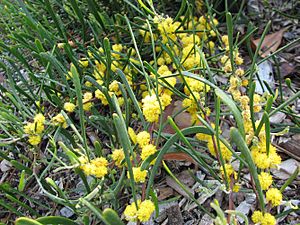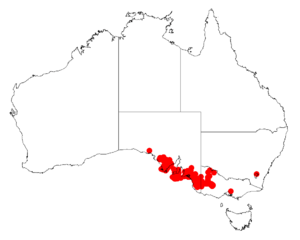Mealy wattle facts for kids
Quick facts for kids Mealy wattle |
|
|---|---|
 |
|
| Scientific classification | |
| Genus: |
Acacia
|
| Species: |
farinosa
|
 |
|
| Occurrence data from AVH | |
| Synonyms | |
|
Racosperma farinosa Pedley |
|
The Acacia farinosa, also known as the Mealy Wattle, is a type of shrub. It is special because it is endemic to Australia. This means it grows naturally only in Australia and nowhere else in the world.
This wattle plant usually grows to be about 1 to 2 metres (3 to 6.5 feet) tall. It has unique leaves called phyllodes that point upwards. Its flowers are yellow and round, like small balls. They usually bloom between August and October in Australia. After the flowers, the plant grows pods that are curled and twisted. These pods can be up to 6 centimetres (2.4 inches) long.
About the Mealy Wattle
The Mealy Wattle was first officially described by an English botanist named John Lindley. He wrote about it in 1838. The plant material he used for his description was collected during an expedition by Thomas Mitchell. This happened in 1836 near a place called Lake Charm, Victoria. Lindley's description was published in Mitchell's book, Three Expeditions into the interior of Eastern Australia.
Where it Grows Naturally
You can find the Mealy Wattle growing naturally in South Australia and Victoria. It likes to live in areas with many shrubs and in woodlands. Often, it grows alongside other plants like Eucalyptus incrassata (a type of gum tree) and Melaleuca uncinata (a type of paperbark).
Growing Mealy Wattle
People sometimes plant the Mealy Wattle in gardens. It can be used as a groundcover, which means it spreads out low to the ground. This makes it good for covering soil, especially in areas near the coast.

